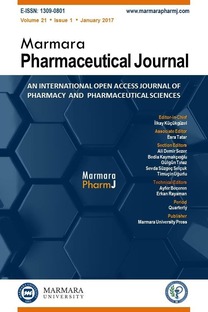Chemical Constituents, Cytotoxic, Antioxidant and Cholinesterases Inhibitory Activities of Silene Compacta (Fischer) Extracts
___
1. Davis PH, Mill RR, Tan K. Silene L. In: Flora of Turkey and the East Aegean Islands, suppl. 10. Edinburgh Univ. Press, Edinburgh. 1988.2. Baytop T. Therapy with Plants in Turkey (Past and Present). Publications of Istanbul University, Istanbul.1984.
3. Laghetti G, Perrino P. Utilization of Silene vulgaris (Moench.) Garcke in Italy. Econ Bot 1994; 48: 337–9.
4. Glensk M, Wray V, Nimtz M, Schoepke T. Silenosides A-C, triterpenoid saponins from Silene vulgaris. J Nat Prod, 1999; 62: 717-21.
5. Gaidi G, Miyamoto T, Laurens V, Dubois MAL. New acylated triterpene saponins from Silene fortunei that modulate lymphocyte proliferation. J Nat Prod, 2002; 65: 1568–72.
6. Zibareva L, Yeriomina VI, Munkhjargal N, Girault JP, Dinan L, Lafont R. The phytoecdysteroid profiles of 7 species of Silene (Caryophyllaceae). Arch Insect Biochem Physiol 2009; 72: 234–48.
7. Gasiorowski K, Brokos B, Glensk M, Schöpke T. Immunomodulatory activity of the saponinrich fraction from roots of Silene vulgaris Garcke: initial study. Pharmazie 1999; 54: 864–6.
8. Mamadalieva NZ, Chenko NT, Yuldasheva NK, Egamberdieva DR, Zhanibekov A, Dzhukharova MK, Glushenkova AI. Fatty acid composition and antibacterial activity of CHCl3 extracts of three plants of the genus Silene. Chem Nat Comp 2010; 46; 95-6.
9. Kucukboyaci N, Ozçelik B, Adıguzel N, Goren AC. Fatty-acid compositions of Silene vulgaris and S. cserei subsp. aeoniopsis seeds and their antimicrobial activities. Chem Nat Compd 2010; 46: 88-91.
10. Vivek B, Savita S, Chul KS. Chemical composition and antifungal activity of essential oil and various extract of Silene armeria L. Bioresource Technol 2008; 99: 8903-8.
11. Howes MJR, Perry NSL, Houghton PJ. Plants with traditional uses and activities relevant to the management of Alzheimer’s disease and other cognitive disorders. Phytother Res 2003; 17: 1-18.
12. Ertas A, Boga M, Yılmaz MA, Yesil Y, Hasimi N, Kaya MS, Temel H, Kolak U. Chemical compositions by using LC-MS/ MS and GC-MS and biological activities of Sedum sediforme (Jacq.) Pau. J Agr Food Chem 2014; 62: 4601–9.
13. Yamazaki E, Inagaki M, Kurita O, Inoue T. Antioxidant activity of Japanese pepper (Zanthoxylum piperitum) fruit. Food Chem 2007; 100: 171-7.
14. Ertas A, Boga M, Yılmaz MA, Yesil Y, Tel G, Temel H, Hasimi N, Gazioglu I, Ozturk M, Ugurlu P. A detailed study on the chemical and biological profiles of essential oil and methanol extract of Thymus nummularius (Anzer tea): Rosmarinic acid. Ind Crop Prod 2015; 67: 336-45.
15. Ertas A, Boga M, Kizil M, Ceken B, Goren AC, Hasimi N, Demirci S, Topcu G, Kolak U. Chemical profile and biological activities of Veronica thymoides subsp. pseudocinerea. Pharm Biol 53; 2015: 334-9.
16. Ertas A, Yilmaz MA, Firat M. Chemical profile by LC–MS/ MS, GC/MS and antioxidant activities of the essential oils and crude extracts of two Euphorbia species. Nat Prod Res 2015; 29: 529-34.
17. Slinkard K, Singleton VL. Total phenol analyses: Automation and comparison with manual methods. Am J Enol Viticult 1977; 28: 49-55.
18. Moreno MIN, Isla MI, Sampietro AR, Vattuone MA. Comparison of the free radical-scavenging activity of propolis from several regions of Argentina. J Ethnopharmacol 2000; 71: 109-14.
19. Miller HE. A simplified method for the evaluation of antioxidants. J Am Oil Chem Soc 1971; 48: 91.
20. Blois MS. Antioxidant determinations by the use of a stable free radical. Nature 1958; 181: 1199-1200.
21. Re R, Pellegrini N, Proteggente A, Pannala A, Yang M, Rice- Evans C. Antioxidant activity applying an improved ABTS radical cation decolorization assay. Free Radical Bio Med 1999; 26: 1231-7.
22. Apak R, Guclu K, Ozyurek M, Karademir SE. Novel total antioxidant capacity index for dietary polyphenols and vitamins C and E, using their cupric ion reducing capability in the presence of neocuproine: CUPRAC Method. J Agric Food Chem 2004; 52: 7970-81.
23. Ellman GL, Courtney KD, Andres V, Featherstone RM. A new and rapid colorimetric determination of acetylcholinesterase activity. Biochem Pharmacol 1961; 7: 88-95.
24. Guo N, Ding W, Wang Y, Hu Z, Wang Z, Wang Y. An LC– MS/MS method for the determination of salidroside and its metabolite p-tyrosol in rat liver tissues. Pharm Biol 2014; 52: 637–45.
25. Gatto MA, Ippolito A, Linsalata V, Cascarano NA, Nigro F, Vanadia S, Di Venere D. Activity of extracts from wild edible herbs against postharvest fungal diseases of fruit and vegetables. Postharvest Biol Tec 2011; 61: 72-82.
- ISSN: 1309-0801
- Yayın Aralığı: Yılda 6 Sayı
- Başlangıç: 1985
- Yayıncı: Marmara Üniversitesi
Wild Edible Plants of Savaştepe District (Balıkesir, Turkey)
EBRU ÖZDEMİR NATH, ŞÜKRAN KÜLTÜR
Investigation of the Effects of Edaravone on Valproic Acid Induced Tissue Damage in Pancreas
Chemical composition, acute and sub-acute toxicity of Satureja khuzestanica essential oil in mice
Shirzad FALLAHI, Maryam BEYRANVAND, Hossein MAHMOUDVAND, Hassan NAYEBZADEH, Farnaz KHEIRANDISH, Sareh JAHANBAKHSH
Hayal ÇOBANOĞLU, Münevver COŞKUN, Mahmut COŞKUN, Akın ÇAYIR
Gholamreza ASGHARI, Mohamad AKBARI, Majid ASADI-SAMANI
In vivo evaluation of Berberis vulgaris extract on acute toxoplasmosis in mice
Hossein MAHMOUDVAND, Amir Tavakoli KARESHK, Amir KEYHANİ, Naser ZİA ALİ, Mohammad Reza AFLATOONİAN
Sayema AREFİN, Mohammad Salim HOSSAIN, Shamme Akter NESHE, Mamun OR RASHİD, Mohammad Tohidul AMİN, Saddam HUSSEİN
PP SUBRAMANI, SV KHARE, SP CHOUDHARİ, SP PHALLE, SS KUMBHAR, VS KAVADE, AA PRATAVALE, PB CHOUDHARİ
